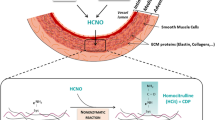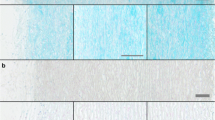Summary
Stiffening of blood vessel walls occurs in the early stages of atherosclerosis, and this process is known to occur earlier in diabetic subjects. The effect could be due, in part, to glycation. Although collagen is responsible for ensuring the ultimate tensile strength of the tissue, elastin largely determines the compliance of the vessel wall in the normal physiological range of pressures and this appears to be closely matched to haemodynamic requirements. Changes in elastin are therefore likely to affect optimal function of the tissue. We have investigated the susceptibility of elastin to glycation and effects of glycation on its mechanical and physicochemical properties. We found that purified elastin and a collagen-elastin preparation from the porcine thoracic aorta rapidly incorporated glucose and ribose, the extent increasing linearly with increasing concentration and reaching a maximum after 7 days at 37°C. Biochemical analysis showed that about one of the five lysines available per elastin monomer was glycated after 12 days incubation at a sugar concentration of 250 mmol/l. In long-term incubations glycation was associated with the appearance of the advanced glycation end products, the fluorescent cross-link pentosidine and the non-fluorescent putative cross-link NFC-1. In both purified elastin and the whole elastin-collagen matrix the slope of the force-extension curve increased significantly with glycation. The greatest increase in stiffness was observed in the elastin-collagen preparation after ribose incubation (250 mmol/l for 1 month), where the slope, at large strain, increased by 56±19 % (mean±SD,n=12). The diameter of the tissue at 1 N force also changed: for elastin there was an increase in length of approximately 5 %, but for the elastin-collagen there was a decrease of similar magnitude indicating that glycation introduces differential strains within the fibrous protein matrix. Potentiometric titration demonstrated that glycation was associated both with loss of basic groups and shifts in pK of the acidic groups, which indicated changes in the environment of the charge groups due to conformational rearrangements. Changes in ion binding were dependent on pH, and were consistent with a reduction in effective anionic charge. Calcium binding to elastin was increased at acid pH, but decreased at higher pH. We suggest that these effects are not only due to changes in the charge profile, but also in the conformation of the molecule resulting from glycation of the charged lysine and arginine side-chain residues.
Similar content being viewed by others
Abbreviations
- AGE:
-
Advanced glycation end product
- EDTA:
-
ethylenediaminetetraacetic acid
- HPLC:
-
high pressure liquid chromatography
- NFC-1:
-
non-fluorescent putative cross-link
- PBS:
-
phosphate buffered saline
- TFA:
-
trifluoroacetic acid
References
Banga JD, Sixma JJ (1986) Diabetes mellitus, vascular disease and thrombosis. Clin Haematol 15: 465–492
Garcia MJ, McNamara PM, Gordon T, Kannell WB (1974) Morbidity and mortality in diabetics in the Framingham population. Sixteen year follow-up study. Diabetes 23: 105–111
Chace KV, Carabele R, Nordquist RE (1991) The role of nonenzymatic glycosylation, transition metals, and free radicals in the formation of collagen aggregates. Arch Biochem Biophys 288: 473–480
Fu MX, Knetch KJ, Thorpe SR, Baynes JW (1992) The role of oxygen in cross-linking and chemical modification of collagen by glucose. Diabetes 41: 42–48
Wolff SP, Dean RT (1987) Glucose autooxidation and protein modification. The potential role of ‘autoxidative glycosylation’ in diabetes. Biochem J 245: 243–250
Sell DR, Monnier VM (1989) Structure elucidation of a senescence cross-link from human extracellular matrix. Implication of pentoses in the aging process. J Biol Chem 264: 21597–21602
Bailey AJ, Sims TJ, Avery NC, Halligan EP (1995) Non-enzymic glycation of fibrous collagen: reaction products of glucose and ribose. Biochem J 305: 385–390
Baynes JW, Monnier VM (1989) The Maillard Reaction in ageing, diabetes and nutrition. Alan R. Liss, Inc. New York
Yue DK, McLennan S, Delbridge L, Handelsman DJ, Reeve T, Turtle JR (1983) The thermal stability of collagen in diabetic rats: correlation with severity of diabetes and non-enzymatic glycosylation. Diabetologia 24: 282–285
Andreassen TT, Seyer-Hansen K, Bailey AJ (1981) Thermal stability, mechanical properties and reducible cross-links of rat tail tendon in experimental diabetes. Biochem. Biophys. Acta 677: 313–317
Andreassen TT, Seyer-Hansen K (1981) In vitro effects of glucose on the biophysical properties of collagen. Diabetologia 21: 242–243
Galeski A, Kastelic J, Baer E, Kohn RR (1977) Mechanical and structural changes in rat tail tendon induced by alloxan diabetes and aging. J Biomech 10: 775–782
Guitton JD, Le Pape A, Muh JP (1984) Influence of in vitro non-enzymatic glycosylation on the physicochemical parameters of type 1 collagen. Coll Relat Res 4: 253–264
Menzel EJ, Reihsner R (1991) Alterations of biochemical and biomechanical properties of rat tail tendons caused by non-enzymatic glycation and their inhibition by dibasic amino acids arginine and lysine. Diabetologia 34: 12–16
Dobrin PB (1983) Vascular mechanics. In: Shephard JT, Abboud FM (eds) Handbook of physiology, Sec. 2. The Cardiovascular System, Vol.III. American Physiological Society, Bethesda, Md., pp 65–102
Kwan CY, Wang RR, Beazley JS, Lee RM (1988) Alterations of elastin and elastase-like activities in aortae of diabetic rats. Biochem Biophys Acta 967: 322–325
Tomizawa H, Yamazaki M, Kunika K, Itakura M, Yamashita K (1993) Association of elastin glycation and calcium deposit in diabetic rat aorta. Diabetes Res Clin Pract 19: 1–8
Partridge SM, Davis HF, Adair GS (1955) Soluble proteins derived from partial hydrolysis of elastin. Biochem J 61: 11–21
Jackson DS, Cleary EG (1967) The determination of collagen and elastin. Method Biochem Anal 15: 25–76
Winlove CP, Parker KH (1990) Influence of solvent composition on the mechanical properties of arterial elastin. Biopolymers 29: 729–735
Winlove CP, Parker KH, Ewins AR, Birchler NE (1992) The polyelectrolyte properties of elastin. J Biomech 114: 293–300
Steven FS, Thomas H (1973) Preparation of insoluble collagen from human cartilage. Biochem J 135: 245–247
Winlove CP, Parker KH, Ewins AR (1988) The uptake of ions and neutral solutes by the artery and artery wall preparations. Conn Tiss Res 18: 83–94
Trueb B, Holenstein CG, Fischer RW, Winterhalter KH (1980) Nonenzymatic glycosylation of proteins. A warning. J Biol Chem 255: 6717–6720
Schleicher E, Wieland OH (1981) Specific quantitation by HPLC of protein (lysine) bound glucose in human serum albumin and other glycosylated proteins. J Clin Chem Clin Biochem 19: 81–87
Ayad S, Boot-Handford RP, Humphries MJ, Kadler KE, Shuttleworth CA (1994) The Extracellular Matrix Facts Book. Academic Press, London
Liu SQ, Fung YC (1992) Influence of STZ-induced diabetes on zero-stress states of rat pulmonary and systemic arteries. Diabetes 41: 136–146
Urry DW (1971) Neutral sites for calcium ion binding to elastin and collagen: a charge neutralization theory for calcification and its relationship to atherosclerosis. Proc Nat Acad Sci USA 68: 810–814
Author information
Authors and Affiliations
Rights and permissions
About this article
Cite this article
Winlove, C.P., Parker, K.H., Avery, N.C. et al. Interactions of elastin and aorta with sugars in vitro and their effects on biochemical and physical properties. Diabetologia 39, 1131–1139 (1996). https://doi.org/10.1007/BF02658498
Received:
Revised:
Published:
Issue Date:
DOI: https://doi.org/10.1007/BF02658498




